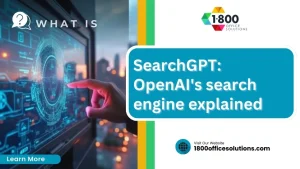Key Insights on What Edge Computing Is and Its Benefits
Is your business struggling with slow data processing and increased IT security risks? This article breaks down edge computing, exploring how it functions and why it matters for businesses. Readers will learn about key use cases and compare edge computing with traditional IT methods, gaining actionable insights to help improve efficiency and security.
What Is Edge Computing?

Edge computing processes data closer to the source, reducing latency compared to centralized data center solutions. This approach supports wireless systems and enables faster decision-making for improved operational performance.
Organizations adopt edge computing to drive innovation in their operations, enabling real-time analytics and timely responses. The method benefits applications such as predictive maintenance by analyzing equipment data at the perimeter.
Edge computing supports wireless networks by bringing computing power to the network’s edge. This setup allows businesses to mitigate delays typical of remote data centers, which proves crucial in critical response scenarios.
Industries use edge computing to improve service outcomes by merging data center efficiency with local processing. The technology also supports predictive maintenance and benefits patient care by ensuring timely data availability during emergencies.
How Does Edge Computing Function?

Edge computing functions by processing data directly at local devices or gateways, where the computer executes tasks swiftly without sending data to a distant data center. This system reduces delays, optimizing telecommunications protocols and improving overall performance.
A company looking to boost productivity can benefit from edge computing services that analyze data near the source. This approach allows the available computer resources to handle critical processes with minimal delay.
Organizations apply a patch-like update strategy to ensure their edge computing services remain current and efficient. With consistent computer maintenance, businesses gain reliable performance even during heavy data traffic.
Telecommunications networks rely on edge computing to streamline data flow and reduce the strain on central systems. A company using this method experiences more stable and secure operations via advanced computer algorithms and efficient patch updates.
Why is Edge Computing Significant?

Edge computing transforms data processing speed and bolsters security measures. It improves operational efficiency while reducing cost and risk through reliable performance. Driven by intel standards and ethernet protocols, this evolution underpins effective marketing strategies. Detailed insights cover data processing acceleration, enhanced security, operational efficiency, cost reduction, and performance reliability.
Impact on Data Processing Speed
Edge computing reduces latency by processing raw data near the source, cutting the road to delays associated with traditional cloud computing. This localized processing minimizes transfer time to a centralized database, ensuring that operations run smoother and respond faster to critical needs.
The approach provides a more direct path for managing data, bypassing some of the lengthy hops found in remote server configurations. By handling data at the edge, organizations can lower latency while keeping the load off both the cloud computing system and the central database.
Enhancements in Security Measures
Edge computing improves security by implementing robust encryption methods directly at local nodes, reducing exposure to breaches and protecting data sovereignty in real-time environments. The approach benefits systems that incorporate an operating system designed for edge devices, ensuring that secure protocols remain active throughout the supply chain.
Businesses integrate edge computing with augmented reality solutions to provide secure and interactive experiences while managing vast amounts of data effectively. This strategy prioritizes strong encryption and localized processing, which empowers organizations to control data sovereignty and maintain system integrity across a complex supply chain.
Effect on Operational Efficiency
The use of edge computing solutions improves operational efficiency by enabling faster processing at the source, reducing reliance on distant data centers. This method assists various applications such as sensor data analysis, storage management, and edge IoT tasks, ensuring that businesses quickly utilize the tool for real-time decision-making.
Business operations benefit from the combination of local processing and technology integration, which minimizes lag and controls data flow. By processing sensor input and managing storage loads efficiently, the system supports edge computing solutions that empower organizations to address real-time challenges using proven edge IoT techniques.
Cost Reduction Opportunities
Edge computing reduces reliance on distant cloud systems, decreasing network congestion and lowering operating expenses for businesses. Efficient data processing at local nodes allows organizations to optimize resource allocation, which proves beneficial for smart city applications and increases overall efficiency.
By handling routine tasks locally, companies experience fewer delays and smoother operations, leading to cost reduction and improved budget management. This strategy lowers external infrastructure maintenance costs and relieves pressure on centralized cloud servers, ensuring efficient data processing while supporting smart city growth.
Reliability and Performance Benefits
The system benefits from localized processing that improves reliability while ensuring that data analysis occurs quickly and accurately. This method supports manufacturing processes by providing precise control for the robot and reliable updates from the original equipment manufacturer.
The approach boosts performance by handling crucial tasks directly at the edge, reducing the risk of delays and system downtime. Businesses in manufacturing environments gain practical advantages from efficient data analysis, assuring a smooth operation that meets the demands of original equipment manufacturer standards.
Key Use Cases for Edge Computing

Manufacturing applications, smart cities, healthcare innovations, autonomous vehicles, and retail experiences exemplify effective edge computing use cases. Each topic highlights data management improvements, supports an expanding ecosystem with edge IOT gateway integration, and complements solutions like edge aws, all while harnessing the wind of innovation.
Applications in Manufacturing
Manufacturing processes benefit from edge computing by utilizing localized data processing. The reliable concept reduces delays by integrating a wireless network and a dedicated gateway, resulting in increased speed and improved real-time decision-making for machinery and production lines.
Edge computing assists manufacturers in optimizing operations by offering actionable insights from critical data. This method employs a network gateway to process input closer to the source, ensuring that information flows quickly and efficiently, directly addressing industry pain points.
Utilization in Smart Cities
Edge computing supports smart city initiatives by reducing delays in data transmission and providing fast processing near the source. This method helps optimize energy usage and ensures timely updates from critical machine sensors while complying with standards such as etsi.
The use of localized processing enables authorities to quickly react to real-time events and improve operational decisions. By employing efficient data handling protocols, the system supports a more resilient machine network that guarantees smoother transmission of vital information.
Role in Healthcare Innovations
The healthcare sector benefits from distributed computing systems that improve patient care by enhancing real-time surveillance of critical data. Organizations combine edge and cloud computing to support artificial intelligence applications that monitor vital signs and predict emergencies, helping the community receive timely interventions.
Innovative healthcare facilities implement edge and cloud computing solutions to streamline medical data processing and support distributed computing networks. By integrating artificial intelligence and robust surveillance systems, hospitals and clinics can efficiently manage patient information and improve overall service outcomes for the community.
Involvement in Autonomous Vehicles
The integration of edge computing in autonomous vehicles supports a hybrid operation model that improves real-time data collection for efficient control systems. This method offers benefits similar to its applications in agriculture, where on-site processing aids in traffic control and immediate decision-making for vehicle maintenance.
The computing edge approach in self-driving cars reduces response time by processing signals near the source, ensuring safety and continuous system performance. The system’s capacity for rapid data collection and effective maintenance scheduling underscores its potential to transform transportation and related sectors.
Adoption in Retail Experiences
The retail sector benefits from localized data processing, where an organization improves its radio access network and boosts revenue through real-time system updates. This method increases productivity by using solutions similar to AWS for immediate decision-making.
Retail establishments optimize operations by employing in-store devices for data analysis, enabling precise inventory management and customer interaction. The approach supports an organization in refining its radio access network and enhancing revenue, ultimately driving overall productivity.
Comparing Edge Computing to Cloud Computing

Edge computing shifts data processing from a distant data center to the edge of the cloud, offering enhanced performance compared to traditional cloud services. The approach tightly integrates with fog solutions to improve local data handling.
The model supports digital twin applications by providing real-time data to simulate physical processes accurately. This capacity accelerates digital transformation efforts across various industries.
Edge computing minimizes latency by processing data on local devices before moving it through the access network. This results in quicker responses than relying solely on cloud computing.
Organizations benefit from combining edge and cloud computing to achieve a balanced infrastructure. The method creates an efficient system where the edge of the cloud works in tandem with digital twin technologies and fog architectures.
Identifying Edge Computing Challenges

This section examines key challenges in edge computing, including security and privacy concerns, data management complexities, cost implications for implementation, and interoperability issues. It also addresses skill gaps in the workforce while touching on topics like oil, brick and mortar systems, software reliability, predictive analytics, and backhaul management.
Security and Privacy Concerns
The computing infrastructure within edge computing brings unique challenges regarding security and privacy. An unsecured edge device can allow unwanted signal interference and unauthorized access to sensitive data at a point of sale, compromising customer and organizational safety.
Interoperability issues among various devices demand careful security measures to ensure data remains protected. Real-world cases have shown that maintaining strict protocols for each edge device mitigates risks while sustaining efficient connectivity and secure transactions across the computing network.
Data Management Complexities
The management of data in edge computing involves complexities that challenge organizations to maintain safety and efficiency while transmitting broadband communications over network edge device systems. The process demands specialized learning to ensure seamless operation, including periodic audits and real-world testing similar to a Safari through intricate system protocols.
Organizations face hurdles in coordinating the diverse data streams processed by each network edge device while keeping user safety at the forefront. Practical steps include adopting modern broadband standards and comprehensive learning programs to address compatibility issues and ensure stable operations.
Cost Implications for Implementation
Implementing edge computing requires a stable infrastructure and careful architectural planning, which can increase initial setup costs and affect long-term resource allocation. A detailed eBook on cost analysis can offer valuable insights, enabling organizations to optimize their operational efficiency while managing financial implications.
The investment in an advanced architecture for edge computing might demand higher capital expenditures in the early stages. By studying resource allocation strategies in dedicated eBooks, businesses can better prepare for the infrastructure costs, ensuring sustained operational efficiency over time.
Interoperability Issues
Interoperability challenges require organizations to ensure that systems such as Microsoft Azure, Firefox, and red hat smoothly integrate throughout the product lifecycle. This approach bolsters operational intelligence and minimizes disruptions in data exchange between varied network elements.
Efficient collaboration among these platforms enables firms to manage the product lifecycle with consistency and precision. By streamlining data management practices, organizations can overcome interoperability gaps and maintain a high level of intelligence in system operations.
Skill Gaps in Workforce
Skill gaps in the workforce hinder the full potential of edge computing as organizations struggle to find professionals with experience in scalability and analytics. Workforce challenges also arise in securing expertise from sectors such as factory operations and health to support the complex demands of edge computing applications.
Workforce deficiencies often affect software development teams tasked with integrating edge systems, impacting both project pace and quality. Companies investing in training and upskilling initiatives have seen improved operational efficiency, addressing concerns across the factory, health, and software development arenas.
Future Trends in Edge Computing

Future trends in edge computing include integration with 5G technology, growing IoT expansion, and the evolution of edge AI applications. Shifts in industry standards and new business models emerge alongside enhanced data sovereignty and cloud edge strategies. This discussion highlights radio innovations and dynamic API experiences that drive practical improvements in efficiency and operational performance.
Integration With 5G Technology
Edge computing environments benefit from the integration with 5G technology, which minimizes downtime and enhances data security. Research shows that faster network speeds empower retail operations and various industries to perform real-time analytics with reduced reliance on centralized systems.
The combination of 5G and edge computing leads to improved overall system reliability and efficiency. This integration addresses key operational challenges and supports research initiatives by providing immediate data processing that reinforces robust data security protocols and minimizes response delays.
Effects of IoT Expansion
The expansion of IoT drives a significant shift in data management practices as more devices generate vital information. This growth encourages the adoption of fog computing and computer vision techniques while reducing dependency on traditional cloud storage systems, a trend noted in systems designed by Cisco.
The continuous increase in connected devices compels businesses to integrate advanced solutions that streamline data processing at the network’s edge. Industry leaders apply enhanced security and efficiency measures that optimize information flow and support computer vision applications, following standards set by entities such as Cisco.
Evolution of Edge AI Applications
The evolution of edge AI applications leverages advanced technology to enhance computing on the edge while reducing cost and improving efficiency. This progress addresses industry challenges by ensuring compliance with the general data protection regulation and streamlining inventory management processes.
Industry experts observe that refined edge AI solutions drive operational precision and faster decision-making by processing data locally. This approach offers actionable benefits for businesses looking to reduce expenses and increase system responsiveness through smarter technology integration.
Shifts in Industry Standards
The industry sees changes that affect consumer expectations, leading to smart proof of concept projects that blend established internet protocols with advanced local processing techniques. These shifts in standards bring tangible benefits to the internet of things, ensuring that systems work as fluidly as water to meet modern demands.
New guidelines drive a renewed focus on reliability and speed, resulting in robust proof of concept implementations that enhance consumer experiences. As the internet evolves, these updated standards support seamless connections in the internet of things, functioning smoothly like water in integrated environments.
New Business Models Emerging
Emerging business models in edge computing now focus on integrating smart devices that deliver greater utility and streamline operations. A white paper issued by a leading research firm illustrates how these models drive improvements in vehicle data management and customer experience through localized processing.
Industry experts note that innovative models leverage edge computing to optimize device functionality, ensuring rapid data analysis and increased utility in operational processes. Practical examples, such as dynamic vehicle monitoring systems, underline enhancements in customer experience and overall system efficiency.
Getting Started With Edge Computing

Edge computing implementation starts with assessing infrastructure needs, selecting suitable vendors, formulating rollout strategies, training teams, and measuring success metrics. This process incorporates automation, DevOPs practices, IBM solutions, building automation standards, and 5G connectivity to offer a clear, efficient roadmap for successful edge computing deployment.
Assessing Infrastructure Needs
Organizations begin by evaluating current hardware and software systems to determine if they support advanced machine learning functions. They ensure that routers meet modern traffic management standards while integrating content delivery networks on reliable Linux platforms.
Experts recommend a detailed assessment of existing infrastructure to guarantee efficient processing and data management near the source. The examination includes verifying that network routers handle increased traffic load and that machine learning tools on Linux systems are ready to support evolving content delivery needs.
Selecting Suitable Vendors
When selecting suitable vendors for edge computing, businesses evaluate the ability to support warehouse operations and optimize bandwidth. Vendors with expertise in software engineering provide robust solutions that integrate seamlessly with edge devices examples, ensuring the customer receives practical, reliable technology aligned with operational needs.
Firms should consider vendors with a proven track record in deploying efficient systems that support real-time data processing for warehouse and customer operations. Vendors who demonstrate practical insights in software engineering and effective bandwidth management help bridge the gap between operational demands and technical specifications, ensuring the system is both efficient and scalable.
Developing a Rollout Strategy
This strategy involves identifying strategic touchpoints for business intelligence integration alongside robust security measures that protect sensitive data. The plan should consider using content delivery network systems to efficiently manage operational traffic, and incorporate virtualization technologies for improved resource allocation.
Stakeholders are advised to include practical applications like deploying surveillance cameras at key locations to enhance system monitoring. This approach supports a smooth rollout that aligns virtualization benefits with real-time business intelligence and reliable security protocols.
Training Teams for Implementation
Training teams for implementation involves hands-on sessions where technicians gain insight into managing server configurations and integrating deep learning algorithms for efficient processing. This approach enhances user experience by building a skilled workforce familiar with edge computing tasks and addressing common challenges throughout deployment.
Experts emphasize the significance of structured training programs to equip staff with practical skills in server maintenance and deep learning practices. Such initiatives boost user experience through better system performance and provide actionable insights to simplify day-to-day operations in an edge computing environment.
Measuring Success Metrics
The effectiveness of edge computing can be evaluated by tracking key success metrics such as data processing speed, latency reduction, and resource utilization. Practical insights gained from real-world audits enable businesses to quantify improvements in operational efficiency, ensuring that the edge computing system delivers dependable performance and meets strategic objectives.
Organizations rely on detailed performance benchmarks and clear measurement criteria to verify that their edge computing initiatives satisfy business demands. By monitoring real-time data and analyzing operational outcomes, experts provide actionable recommendations that assist business owners in optimizing edge-based systems while addressing specific performance challenges.
Conclusion
Edge computing processes data near its origin, reducing latency and ensuring faster decision-making. It boosts security by handling sensitive information locally while streamlining operational tasks. Businesses gain an edge in performance and cost management through efficient resource use and improved data flow. Stakeholders benefit by recognizing these capabilities to drive effective and future-ready operations.











